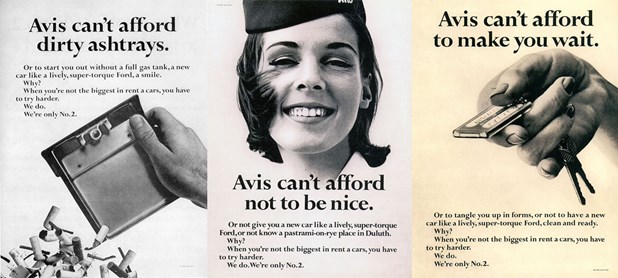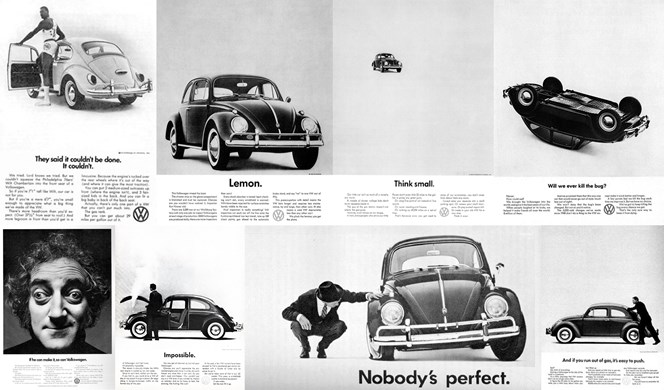Bill Bernbach: 5 ways he revolutionised advertising
Bill Bernbach was an advertiser of the sixties at the forefront of what was called the “Creative Revolution”. After many years working in the advertising industry and despite his success, Bernbach despised the industry’s approach to Advertising. Because he disliked the industry so much, he decided to create his own agency with Ned Doyle and Maxwell Dane and, the 1st of June 1949, “Doyle, Dane, Bernbach” (DDB) started changing advertising as it was known.
He didn’t care about conventions :
One other advertiser was leading the market before the creative revolution and firmly disagreed with Bernbach’s style. In fact, David Ogilvy’s ads were the complete opposite of what DDB was known for.
For him, advertising mainly consisted in putting as much information about the product as possible, with data ranging from the speed of the car to what modifications were made, when they were made, or even the investment price. These ads would be accompanied by a simple picture of the product. Ogilvy’s idea was that the content is more important than how it’s said.
Bernbach, for his part, constantly said that advertising is an art, not a science. Advertising is in constant need to evolve. At the time, consumerism was making it easier to have more and more products on the market and it became essential to be unique. Stating the characteristics of a product wouldn’t work anymore. William Bernbach understood that in advertising the most important characteristic is to be different and create ads that make you stand out. That, more than the product, consumers were interested in the idea behind the product.
He understood that the first step was to get the public interested in the ad. After all, when more and more ads started appearing, the consumer didn’t have time to read them all anymore. Advertising needed to get the future consumer intrigued into looking further into the product.
“In advertising, not to be different is virtually suicidal.”
That thinking evolved until the present day: we can see that it isn’t necessarily the product itself that sells anymore, but rather the idea behind the product, or even the experience it provides.
“100 years from now, the Idea is still going to be more important than all the technology in the world.”
He changed the way agencies work :
Before Bernbach, copywriter and artists didn’t even see each other. Their jobs were done separately, and the copy didn’t have to take the creative part into account when writing the body copy that would, however, be part of the same final work.
Bernbach put as much importance in the type as in the visual. And so, he was the first to pair up copywriters and art directors in teams of two and create what is still called creative teams. By working that way, the AD and copy would exchange ideas to create a link between the body copy and the visual. Working in this way made ads became more creative and more cohesive.
The work environment was more positive and dynamic as the two members of the team would exchange ideas and push their creativity even further, creating award-winning and successful campaigns. Bernbach was also really involved in the work of the people working for him. He would come himself to their office and see what they were doing and gave advice if needed which earned him the respect and the pride of the people he worked with.
“Let us prove to the world that good taste, good art,
and good writing can be good selling”
He promoted diversity before it was considered an issue:
Before the Creative revolution, the advertising industry was a very selective sector. Composed mostly of men from upper-class backgrounds. Women would be either working as secretaries or in the administration and other minorities and working-class men wouldn’t even have a chance to work in that field.
Bernbach would hire people based on their skills and qualifications and not their background. On the subject of creating a team, Bernbach stated: "When we started our agency, we had in mind precisely the kind of people we wanted with us. There were two requirements: You had to be talented and you had to be nice. If you were nice but without talent, we were very sorry, but you just wouldn’t do. We had to ‘make it.’ And only great talent would help us do that. If you were a great talent, but not a nice person, we had no hesitation in saying ‘No.’ Life is too short to sacrifice so much of it, to living with a bastard.”
Having a more diversified team meant that it was easier to develop different points of view and therefore touch a much broader audience that could relate to the ads. When they founded DDB, Bernbach hired Phyllis K. Robinson, whom he had worked with in the past, as the first ever woman chief copywriter.
He was also one of the first to add diversity in his campaigns like the “You don’t have to be Jewish to love Levy’s”. The campaign showed people from different ethnicities could be seen enjoying bread from the Brooklyn-based bakery, Henry S. Levy and Sons. By taking a different approach Bernbach created a campaign that not only won award and plaudits from the advertising world. It created campaigns that worked for clients.


He was thinking big, by making things small :
Often, simplicity is more powerful in advertising than a very big and complex visual. By pairing minimal body copy, a simple picture and a witty headline a powerful piece of communication is created. Especially if the ad ends up in the street, people don’t have time to read it and need to be able to recognise it quickly. Moreover, the consumer won’t remember what you wrote if it doesn’t have any impact.
For example, for Avis’ campaign, “We try harder” is a strong line that is also recurrent in the whole campaign, which creates a marching beat that sticks in peoples heads. When some art directors were still trying to keep ads complicated, Bernbach was encouraging creative teams in their more minimalist ideas and those are the ads that really had an impact at the time and won awards.


His weapon of choice was truth mixed with humor :
It isn’t enough to hammer an idea to a consumer until he buys a product. Emotions are a much more powerful tool. And while repetition is still a big part in a campaign, the content needs to be interesting and grab the prospects’ attention first.
“The most powerful element in advertising is the truth.”
However, that truth isn’t always good to hear. Which is why Bernbach liked using humour to turn a negative fact into something positive for the brand. Why lie? Everyone knew the Beetle was ugly and that Avis was only second largest in car rental. And so what? That’s what makes it different or try harder. People appreciate the truth told in an approachable way.


Indeed, people appreciated Bernach’s style so much that it has stood the test of time and the VW campaign was judged as the top campaign of the 20th century by Advertising Age.
If you’d like to create a campaign that stands out instead of fitting in, come speak to us.
LIKE THE CUT OF OUR JIB?
Start your next project
Come in for a chat and a damn good cup of coffee. We’d be delighted to hear what you’ve got planned and how we can help you with your project.
